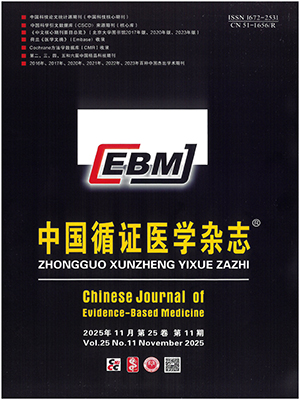| 1. |
Merchant RM, Topjian AA, Panchal AR, et al. Executive summary: 2020 American Heart Association guidelines for cardiopulmonary resuscitation and emergency cardiovascular care. Circulation, 2020, 142(16): S337-S357.
|
| 2. |
中國研究型醫院學會心肺復蘇學專業委員會. 2016 中國心肺復蘇專家共識. 解放軍醫學雜志, 2017, 42(3): 243-269.
|
| 3. |
Kataria S, Ravindran V. Electronic health records: a critical appraisal of strengths and limitations. J R Coll Physicians Edinb, 2020, 50(3): 262-268.
|
| 4. |
Fang AHS, Lim WT, Balakrishnan T. Early warning score validation methodologies and performance metrics: a systematic review. BMC Med Inform Decis Mak, 2020, 20(1): 111.
|
| 5. |
Gerry S, Bonnici T, Birks J, et al. Early warning scores for detecting deterioration in adult hospital patients: systematic review and critical appraisal of methodology. BMJ, 2020, 369: m1501.
|
| 6. |
Obermeyer Z, Emanuel EJ. Predicting the future-big data, machine learning, and clinical medicine. N Engl J Med, 2016, 375(13): 1216-1219.
|
| 7. |
Ehrenstein V, Nielsen H, Pedersen AB, et al. Clinical epidemiology in the era of big data: new opportunities, familiar challenges. Clin Epidemiol, 2017, 9: 245-250.
|
| 8. |
McInnes MDF, Moher D, Thombs BD, et al. Preferred reporting items for a systematic review and meta-analysis of diagnostic test accuracy studies: the PRISMA-DTA statement. JAMA, 2018, 319(4): 388-396.
|
| 9. |
鄔蘭, 張永, 曾憲濤. QUADAS-2 在診斷準確性研究的質量評價工具中的應用. 湖北醫藥學院學報, 2013, 32(3): 201-208.
|
| 10. |
Acharya UR, Fujita H, Sudarshan VK, et al. Automated prediction of sudden cardiac death risk using Kolmogorov complexity and recurrence quantification analysis features extracted from HRV signals. 2015 IEEE International Conference on Systems, Man, and Cybernetics, 2015.
|
| 11. |
Amezquita-Sanchez JP, Valtierra-Rodriguez M, Adeli H, et al. A novel wavelet transform-homogeneity model for sudden cardiac death prediction using ECG signals. J Med Syst, 2018, 42(10): 176.
|
| 12. |
Ebrahimzadeh E, Foroutan A, Shams M, et al. An optimal strategy for prediction of sudden cardiac death through a pioneering feature-selection approach from HRV signal. Comput Methods Programs Biomed, 2019, 169: 19-36.
|
| 13. |
Ebrahimzadeh E, Manuchehri MS, Amoozegar S, et al. A time local subset feature selection for prediction of sudden cardiac death from ECG signal. Med Biol Eng Comput, 2018, 56: 1253-1270.
|
| 14. |
Frolov AV, Vaikhanskaya TG, Melnikova OP, et al. Risk stratification personalised model for prediction of life-threatening ventricular tachyarrhythmias in patients with chronic heart failure. Kardiol Pol, 2017, 75(7): 682-688.
|
| 15. |
Fujita H, Acharya UR, Sudarshan VK, et al. Sudden cardiac death (SCD) prediction based on nonlinear heart rate variability features and SCD index. Appl Soft Comput, 2016, 43: 510-519.
|
| 16. |
Houshyarifar V, Chehel Amirani M. An approach to predict sudden cardiac death (SCD) using time domain and bispectrum features from HRV signal. Biomed Mater Eng, 2016, 27(2-3): 275-285.
|
| 17. |
Kim J, Chae M, Chang HJ, et al. Predicting cardiac arrest and respiratory failure using feasible artificial intelligence with simple trajectories of patient data. J Clin Med, 2019, 8(9): 1336.
|
| 18. |
Shakibfar S, Krause O, Lund-Andersen C, et al. Predicting electrical storms by remote monitoring of implantable cardioverter-defibrillator patients using machine learning. Europace, 2019, 21(2): 268-274.
|
| 19. |
Taye GT, Shim EB, Hwang HJ, et al. Machine learning approach to predict ventricular fibrillation based on QRS complex shape. Front Physiol, 2019, 10: 1193.
|
| 20. |
Acharya UR, Fujita H, Sudarshan VK, et al. An integrated index for detection of sudden cardiac death using discrete wavelet transform and nonlinear features. Knowl Based Syst, 2015, 83: 149-158.
|
| 21. |
Vargas-Lopez O, Amezquita-Sanchez JP, De-Santiago-Perez JJ, et al. A new methodology based on EMD and nonlinear measurements for sudden cardiac death detection. Sensors (Basel), 2019, 20(1): 9.
|
| 22. |
劉光達, 王永祥, 蔡靖, 等. 基于小波變換和 Adaboost 算法的心臟驟停預測模型研究. 生物醫學工程研究, 2017, 36(2): 95-100.
|
| 23. |
王之, 李偉明, 謝佳玲, 等. 心電形態學特征與心率變異性指標預測室顫能力的比較. 中國醫療設備, 2020, 35(4): 15-19, 26.
|
| 24. |
Au-Yeung WM, Reinhall PG, Bardy GH, et al. Development and validation of warning system of ventricular tachyarrhythmia in patients with heart failure with heart rate variability data. PLoS One, 2018, 13(11): e0207215.
|
| 25. |
Bhattacharya M, Lu DY, Kudchadkar SM, et al. Identifying ventricular arrhythmias and their predictors by applying machine learning methods to electronic health records in patients with hypertrophic cardiomyopathy (HCM-VAr-Risk Model). Am J Cardiol, 2019, 123(10): 1681-1689.
|
| 26. |
Cadrin-Tourigny J, Bosman LP, Nozza A, et al. A new prediction model for ventricular arrhythmias in arrhythmogenic right ventricular cardiomyopathy. Eur Heart J, 2019, 40(23): 1850-1858.
|
| 27. |
Cho KJ, Kwon O, Kwon JM, et al. Detecting patient deterioration using artificial intelligence in a rapid response system. Crit Care Med, 2020, 48(4): e285-e289.
|
| 28. |
Do DH, Kuo A, Lee ES, et al. Usefulness of trends in continuous electrocardiographic telemetry monitoring to predict in-hospital cardiac arrest. Am J Cardiol, 2019, 124(7): 1149-1158.
|
| 29. |
Elola A, Aramendi E, Rueda E, et al. Towards the prediction of rearrest during out-of-hospital cardiac arrest. Entropy (Basel), 2020, 22(7): 758.
|
| 30. |
Faxén J, Hall M, Gale CP, et al. A user-friendly risk-score for predicting in-hospital cardiac arrest among patients admitted with suspected non ST-elevation acute coronary syndrome - the SAFER-score. Resuscitation, 2017, 121: 41-48.
|
| 31. |
Fernandes M, Mendes R, Vieira SM, et al. Risk of mortality and cardiopulmonary arrest in critical patients presenting to the emergency department using machine learning and natural language processing. PLoS One, 2020, 15(4): e0230876.
|
| 32. |
Ho JC, Yubin Park None. Learning from different perspectives: robust cardiac arrest prediction via temporal transfer learning. Annu Int Conf IEEE Eng Med Biol Soc, 2017: 1672-1675.
|
| 33. |
Hong S, Lee S, Lee J, et al. Prediction of cardiac arrest in the emergency department based on machine learning and sequential characteristics: model development and retrospective clinical validation study. JMIR Med Inform, 2020, 8(8): e15932.
|
| 34. |
Hsieh MJ, Chiang WC, Sun JT, et al. A prediction model for patients with emergency medical service witnessed out-of-hospital cardiac arrest. J Formos Med Assoc, 2021, 120(5): 1229-1236.
|
| 35. |
Jang DH, Kim J, Jo YH, et al. Developing neural network models for early detection of cardiac arrest in emergency department. Am J Emerg Med, 2020, 38(1): 43-49.
|
| 36. |
Jeffery AD, Dietrich MS, Fabbri D, et al. Advancing in-hospital clinical deterioration prediction models. Am J Crit Care, 2018, 27(5): 381-391.
|
| 37. |
Kawazoe H, Nakano Y, Ochi H, et al. Risk stratification of ventricular fibrillation in Brugada syndrome using noninvasive scoring methods. Heart Rhythm, 2016, 13(10): 1947-1954.
|
| 38. |
Kim J, Park YR, Lee JH, et al. Development of a real-time risk prediction model for in-hospital cardiac arrest in critically ill patients using deep learning: retrospective Study. JMIR Med Inform, 2020, 8(3): e16349.
|
| 39. |
Kwon JM, Kim KH, Jeon KH, et al. Artificial intelligence algorithm for predicting cardiac arrest using electrocardiography. Scand J Trauma Resusc Emerg Med, 2020, 28(1): 98.
|
| 40. |
Kwon JM, Lee Y, Lee Y, et al. An algorithm based on deep learning for predicting in-hospital cardiac arrest. J Am Heart Assoc, 2018, 7(13): e008678.
|
| 41. |
Layeghian Javan S, Sepehri MM, Layeghian Javan M, et al. An intelligent warning model for early prediction of cardiac arrest in sepsis patients. Comput Methods Programs Biomed, 2019, 178: 47-58.
|
| 42. |
Lee H, Shin SY, Seo M, et al. Prediction of ventricular tachycardia one hour before occurrence using artificial neural networks. Sci Rep, 2016, 6: 32390.
|
| 43. |
Li H, Wu TT, Yang DL, et al. Decision tree model for predicting in-hospital cardiac arrest among patients admitted with acute coronary syndrome. Clin Cardiol, 2019, 42(11): 1087-1093.
|
| 44. |
Merath K, Hyer JM, Mehta R, et al. Use of machine learning for prediction of patient risk of postoperative complications after liver, pancreatic, and colorectal surgery. J Gastrointest Surg, 2020, 24(8): 1843-1851.
|
| 45. |
Oliver JM, Gallego P, Gonzalez AE, et al. Predicting sudden cardiac death in adults with congenital heart disease. Heart, 2021, 107(1): 67-75.
|
| 46. |
Ruivo C, Montenegro Sá F, Correia J, et al. The SHIFT model combines clinical, electrocardiographic and echocardiographic parameters to predict sudden cardiac death in hypertrophic cardiomyopathy. Rev Port Cardiol, 2019, 38(12): 847-853.
|
| 47. |
Ueno R, Xu L, Uegami W, et al. Value of laboratory results in addition to vital signs in a machine learning algorithm to predict in-hospital cardiac arrest: A single-center retrospective cohort study. PLoS One, 2020, 15(7): e0235835.
|
| 48. |
Auricchio A, Peluso S, Caputo ML, et al. Spatio-temporal prediction model of out-of-hospital cardiac arrest: Designation of medical priorities and estimation of human resources requirement. PLoS One, 2020, 15(8): e0238067.
|




